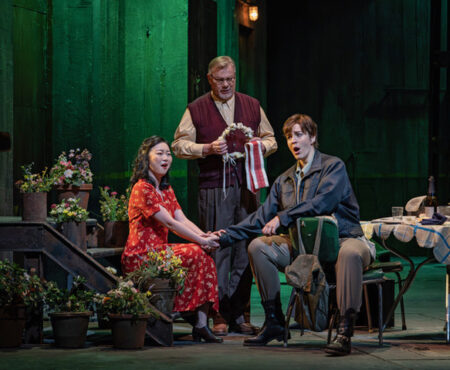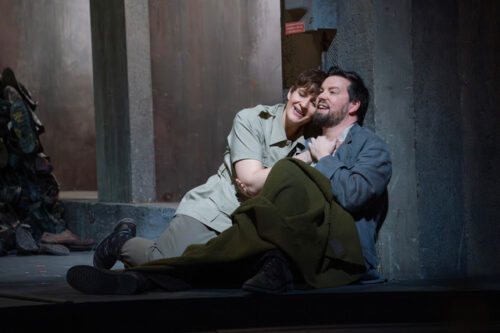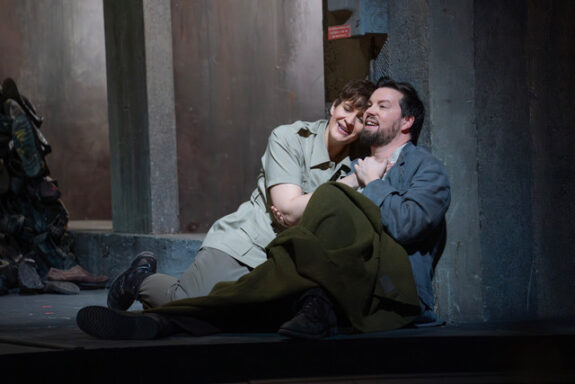 United States Beethoven, Fidelio: Soloists, Metropolitan Opera Chorus and Orchestra / Susanna Mälkki (conductor). Metropolitan Opera, New York, 4.3.2025. (RP)
United States Beethoven, Fidelio: Soloists, Metropolitan Opera Chorus and Orchestra / Susanna Mälkki (conductor). Metropolitan Opera, New York, 4.3.2025. (RP)

Heroism befits Lise Davidsen, and there are few braver operatic heroines than Leonore in Beethoven’s Fidelio. The prodigiously gifted soprano was the raison d’être for the Metropolitan Opera’s revival of Jürgen Flimm’s grim, modernist production, and she triumphed. The rest of the cast was equally impressive, as was conductor Susanna Mälkki in the pit. It adds up to another must-see production this season.
For all the problems that Beethoven had crafting his only completed opera, the gist of the plot is fairly straightforward. A despotic Don Pizzaro imprisons his political adversaries, including Florestan whom the governor, Don Fernando, has been led to believe is dead and not languishing in prison. Leonore, Florestan’s wife, disguises herself as a man, Fidelio, and obtains work at the prison to rescue her husband. Through cunning and pluck, she succeeds.
Flimm’s 2000 production has aged well for all of the wrong reasons. The rows of cells and even the dank basement where Florestan languishes are all too familiar. Prisons have not changed much over the centuries. Large piles of empty suitcases and shoes summon up Nazi concentration camps.
Marzelline’s red dress and the bouquet of red roses that Jaquino gives her are the only bursts of color. Otherwise, it is crisp military uniforms, mid-twentieth-century attire, and tattered prison garb. In the triumphant final scene, the horse on the guard tower is a mystery, but the blue sky with billowing clouds signals the dawn of a new age.
As male impersonators go, Davidsen is convincing, with her height working to her advantage. It is easy to see why Ying Fang’s Marzelline throws over Magnus Deitrich’s earnest, boyish Jaquino for Fidelio. Davidsen also finds the lightness in Leonore. There is a smile on her face as she deftly tosses her cap into the air and catches it when the jailer, Rocco, permits her to assist in his work, opening the door for her to rescue Florestan.
Leonore is not a voice-wrecker of a role, but it requires size, stamina and flexibility, and it is a natural fit for Davidsen. Nothing quite equals the thrill of hearing her voice soar into the vastness of the Met, but even in the lighter passages, such as the roulades at the beginning of Act I, Davidsen was totally at ease. She began Leonore’s great aria, ‘Abscheulicher! Wo eilst du hin?’, in an almost conversational manner. Her phrasing and dynamic shadings were phenomenal, especially the long, spinning phrases that went from zero to a hundred in volume and intensity. Supported by the Met’s fabulous horns, she blazed through the aria’s climaxes.

David Butt Philip’s Florestan was a man worthy of such devotion, as heroic of voice and figure as Davidsen’s Leonore. The voice emerging from the gloom had an arresting bronze-like quality that extended to his ringing high A’s and B-flats. Tomasz Konieczny’s baritone had a steely sheen that cut through the orchestra in Don Pizzaro’s rage aria, ‘Ha! welch’ ein Augenblick’. René Pape was Rocco in the original run of this production and, a quarter of a century later, the voice is still beautiful and firm, but avuncular has replaced bravado with time.
Pampered and pouty, Ying Fang was a delightful Marzelline, expressing the young girl’s hopes of marrying Fidelio in a lyric soprano of exceptional warmth and luster. In his Met debut, tenor Magnus Dietrich displayed a fine lyric tenor and a winning stage presence as Jaquino. Although the Met is hardly bereft of excellent lyric tenors, there is certainly a place for him on the roster.
Stephen Milling was a vocally imposing Don Fernando. In another successful Met debut, tenor Jonghyun Park, a member of the Lindemann Young Artist Program, acquitted himself well in the short, crucial role of the First Prisoner, as did Jeongcheol Cha as the Second Prisoner.
The men of the Met Chorus were at their best in the Prisoner’s Chorus, which was barely audible at the start but grew to impassioned heights as they gave voice to their hopes for freedom. Joined by the women in the finale, their combined sound was equally stirring, though the antics during the general merrymaking could be toned down a bit.
Mälkki instilled passion and excitement into Beethoven’s score, whether the music was lyrical or heroic. The overture was notable for its crispness and articulation, especially in the folk tunes that course through it. Her command of dynamics over extended phrases permitted Davidsen, Butt Philip and the chorus to be equally expressive and impressive. Strings and woodwinds played superbly, but the Met’s brass forces provided the visceral thrills. The horn playing was fluid and warm in the overture, while David Krauss’s ringing trumpet fanfare proclaimed that tyranny had been defeated and love had triumphed.
Rick Perdian
Production:
Director – Jürgen Flimm
Revival Stage director – Gina Lapinski
Sets – Robert Israel
Costumes – Florence von Gerkan
Lighting – Duane Schuler
Chorus director – Tilman Michael
Cast:
Leonore – Lise Davidsen
Florestan – David Butt Philip
Don Pizzaro – Tomasz Konieczny
Rocco – René Pape
Marzelline – Ying Fang
Jaquino – Magnus Dietrich
Don Fernando – Stephen Milling
First Prisoner – Jonghyun Park
Second Prisoner – Jeongcheol Cha
